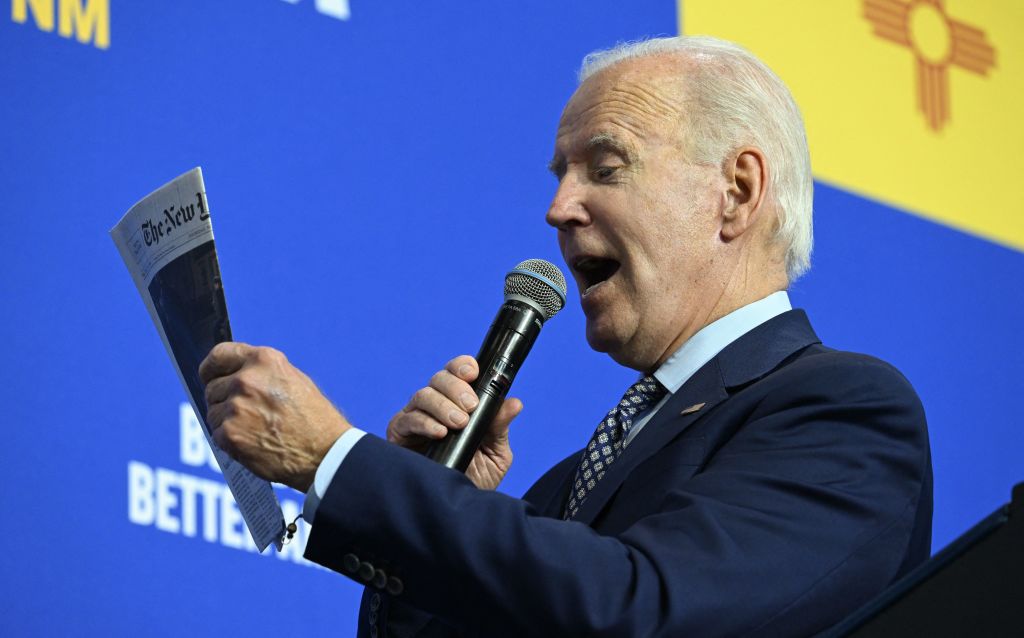Speaking at an event to recognize training for future infrastructure jobs, President Joe Biden made the odd claim that if the power goes out in your house, you can run your home by plugging it into your electric car.
In his remarks in the East Room of the White House on Wednesday, Biden talked about the administration’s “Infrastructure Talent Pipeline Challenge” and the commitments from labor unions and other organizations across the country to begin training new applicants for jobs in broadband, construction and electrification.
About halfway through his speech, however, the president lapsed into another one of his odd asides, this time about electric cars.
“And by the way, in your home, you know, the batteries that we have now — and they’re getting more and more sophisticated,” Biden said. “You know, a lightning storm takes out all the electricity in the house. Guess what? You can plug your car into the house and make it light up.”
When some in the audience laughed, the president insisted it was true.
“You think I’m joking? It’s a little simplistic, but literally you can. Literally you can,” he exclaimed. “Haha. Oh.”
[firefly_embed]
[/firefly_embed]
You can always tell that Biden is disgorging something dubious when he feels compelled to say, “No joke” or “You think I’m joking?” in addition to his statement.
A video of his comments was posted to Twitter by The Post Millennial on Wednesday and had racked up about 500,000 views by Thursday afternoon.
Biden: “A lightning storm takes out all the electricity in the house, guess what? You can plug your car into the house and make it light up. You think I’m joking.” pic.twitter.com/9CM0MpxJKk
— The Post Millennial (@TPostMillennial) November 2, 2022
Biden did not mention what a homeowner should do once he uses up his car’s power and both the house and the car are dead. One certainly can’t recharge a battery if the house has no power. And like others who have found that their EV did not live up to expectations, his comments fell short of reality.
While the president made it clear he wasn’t joking, EV owners might not want to take him too seriously.
At the very least, using an electric vehicle to power a house is inadvisable at this time given the current state of rules, regulations, capabilities and technology.
For instance, if you own a Tesla and you hook your car up to your house, you will void your warranty, Electrek reported last year. As the outlet noted in August, nearly 70 percent of the electric cars on America’s roads are Teslas.
But even for those EVs that aren’t Teslas, it isn’t the best idea in today’s technological climate to use the very costly EV batteries to power a home.
First of all, you can’t just plug household items into an electric car. You need to buy an inverter that can convert the DC power of an EV power pack to the AC current that a house needs.
A home must be equipped with vehicle-to-grid (V2G) or vehicle-to-home technology before a car can be used as a temporary power source for a home. But this tech is not really ready for widespread use. In some cases, local utilities aren’t even allowed to offer the option because of regulatory restrictions, according to Environment America.
Further, the price is prohibitive for many people. It could cost as much as $5,500 for a homeowner to install a new V2G setup to use a car to power a home, according to the National Renewable Energy Laboratory.
In the end, while Biden was technically correct that an EV can power a house for a short time, it just isn’t as simple as plugging your refrigerator, air-conditioner or TV into your car in a time of need.
A lot of expense has to be put into it before EV owners can do so. Also, in some cases, EVs aren’t even set up to be used in this way. And in others, if an EV is used the way Biden suggested, the car owner would void his warranty.
Instead of jumping through hoops to use an EV to power a house, it probably would be better if Biden stopped trying to force Americans into buying expensive EVs and instead unshackled our domestic oil industry.
This article appeared originally on The Western Journal.
























